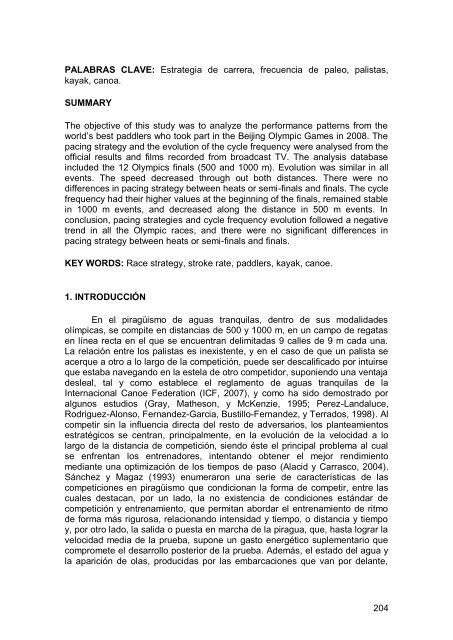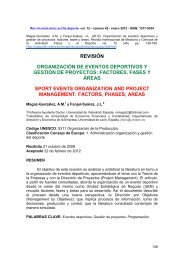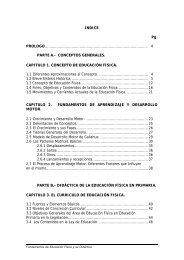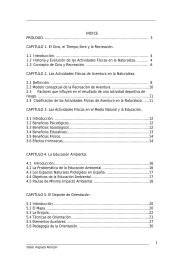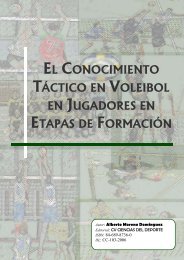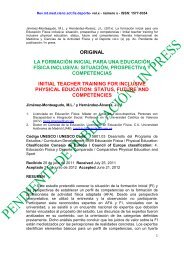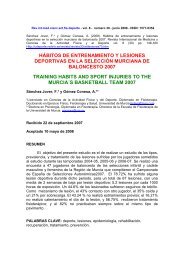Texto en PDF - Comunidad Virtual CIENCIAS DEL DEPORTE ...
Texto en PDF - Comunidad Virtual CIENCIAS DEL DEPORTE ...
Texto en PDF - Comunidad Virtual CIENCIAS DEL DEPORTE ...
You also want an ePaper? Increase the reach of your titles
YUMPU automatically turns print PDFs into web optimized ePapers that Google loves.
PALABRAS CLAVE: Estrategia de carrera, frecu<strong>en</strong>cia de paleo, palistas,<br />
kayak, canoa.<br />
SUMMARY<br />
The objective of this study was to analyze the performance patterns from the<br />
world’s best paddlers who took part in the Beijing Olympic Games in 2008. The<br />
pacing strategy and the evolution of the cycle frequ<strong>en</strong>cy were analysed from the<br />
official results and films recorded from broadcast TV. The analysis database<br />
included the 12 Olympics finals (500 and 1000 m). Evolution was similar in all<br />
ev<strong>en</strong>ts. The speed decreased through out both distances. There were no<br />
differ<strong>en</strong>ces in pacing strategy betwe<strong>en</strong> heats or semi-finals and finals. The cycle<br />
frequ<strong>en</strong>cy had their higher values at the beginning of the finals, remained stable<br />
in 1000 m ev<strong>en</strong>ts, and decreased along the distance in 500 m ev<strong>en</strong>ts. In<br />
conclusion, pacing strategies and cycle frequ<strong>en</strong>cy evolution followed a negative<br />
tr<strong>en</strong>d in all the Olympic races, and there were no significant differ<strong>en</strong>ces in<br />
pacing strategy betwe<strong>en</strong> heats or semi-finals and finals.<br />
KEY WORDS: Race strategy, stroke rate, paddlers, kayak, canoe.<br />
1. INTRODUCCIÓN<br />
En el piragüismo de aguas tranquilas, d<strong>en</strong>tro de sus modalidades<br />
olímpicas, se compite <strong>en</strong> distancias de 500 y 1000 m, <strong>en</strong> un campo de regatas<br />
<strong>en</strong> línea recta <strong>en</strong> el que se <strong>en</strong>cu<strong>en</strong>tran delimitadas 9 calles de 9 m cada una.<br />
La relación <strong>en</strong>tre los palistas es inexist<strong>en</strong>te, y <strong>en</strong> el caso de que un palista se<br />
acerque a otro a lo largo de la competición, puede ser descalificado por intuirse<br />
que estaba navegando <strong>en</strong> la estela de otro competidor, suponi<strong>en</strong>do una v<strong>en</strong>taja<br />
desleal, tal y como establece el reglam<strong>en</strong>to de aguas tranquilas de la<br />
Internacional Canoe Federation (ICF, 2007), y como ha sido demostrado por<br />
algunos estudios (Gray, Matheson, y McK<strong>en</strong>zie, 1995; Perez-Landaluce,<br />
Rodriguez-Alonso, Fernandez-Garcia, Bustillo-Fernandez, y Terrados, 1998). Al<br />
competir sin la influ<strong>en</strong>cia directa del resto de adversarios, los planteami<strong>en</strong>tos<br />
estratégicos se c<strong>en</strong>tran, principalm<strong>en</strong>te, <strong>en</strong> la evolución de la velocidad a lo<br />
largo de la distancia de competición, si<strong>en</strong>do éste el principal problema al cual<br />
se <strong>en</strong>fr<strong>en</strong>tan los <strong>en</strong>tr<strong>en</strong>adores, int<strong>en</strong>tando obt<strong>en</strong>er el mejor r<strong>en</strong>dimi<strong>en</strong>to<br />
mediante una optimización de los tiempos de paso (Alacid y Carrasco, 2004).<br />
Sánchez y Magaz (1993) <strong>en</strong>umeraron una serie de características de las<br />
competiciones <strong>en</strong> piragüismo que condicionan la forma de competir, <strong>en</strong>tre las<br />
cuales destacan, por un lado, la no exist<strong>en</strong>cia de condiciones estándar de<br />
competición y <strong>en</strong>tr<strong>en</strong>ami<strong>en</strong>to, que permitan abordar el <strong>en</strong>tr<strong>en</strong>ami<strong>en</strong>to de ritmo<br />
de forma más rigurosa, relacionando int<strong>en</strong>sidad y tiempo, o distancia y tiempo<br />
y, por otro lado, la salida o puesta <strong>en</strong> marcha de la piragua, que, hasta lograr la<br />
velocidad media de la prueba, supone un gasto <strong>en</strong>ergético suplem<strong>en</strong>tario que<br />
compromete el desarrollo posterior de la prueba. Además, el estado del agua y<br />
la aparición de olas, producidas por las embarcaciones que van por delante,<br />
204


